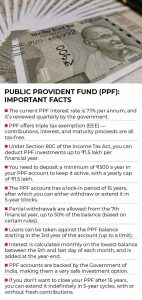Key Takeaways
- PPF can make you a crorepati with disciplined investing over 25 years
- Current interest rate is 7.1% with EEE tax benefits
- Maximum annual investment limit is ₹1.5 lakh
- 15-year lock-in period with extension options
The Public Provident Fund (PPF) offers a proven path to becoming a crorepati through disciplined, long-term investing. Starting at age 21 with maximum contributions, you could potentially accumulate over ₹1 crore by age 46, well before traditional retirement.
This government-backed scheme provides 7.1% interest with complete tax exemption on principal, interest, and maturity amount. Its unique compounding benefits make it particularly powerful for conservative investors seeking stable, tax-efficient returns.
PPF Account Eligibility and Investment Limits
Any resident Indian can open a single PPF account in their name. Parents or guardians can also open accounts for minor children or dependents with disabilities. Accounts are available at post offices, designated banks, and through online banking services.
Investment limits:
- Minimum: ₹500 per financial year
- Maximum: ₹1.5 lakh per financial year
You can deposit the amount in lump sum or installments. The ₹1.5 lakh limit includes contributions to your own account and any minor accounts you manage.
Tax Benefits and Interest Calculation
PPF qualifies as an EEE (Exempt-Exempt-Exempt) instrument, making all aspects tax-free. Contributions up to ₹1.5 lakh qualify for deduction under Section 80C in the old tax regime. While new regime users don’t get Section 80C benefits, the interest and maturity amounts remain completely tax-free.
The Finance Ministry reviews PPF rates quarterly. Interest is calculated monthly on the lowest balance between the 5th and month-end, then credited annually. For maximum benefit, make lump sum deposits between April 1-5 each year.
Withdrawal Rules and Loan Facilities
Partial withdrawals become available after completing five years from account opening. You can withdraw up to 50% of the balance, calculated from the lower of the fourth preceding year or previous year’s balance.
Loan facilities are available between the 3rd and 6th financial years, up to 25% of the balance from two years prior. Loans must be repaid within 36 months with 1% interest, rising to 6% for delays.
Premature closure is permitted only for specific circumstances including life-threatening illnesses, higher education needs, or change to NRI status.
Maturity Options and Wealth Creation
PPF accounts mature after 15 years from the financial year of opening. At maturity, you have three choices:
- Withdraw the entire balance and close the account
- Continue without deposits while earning interest and making annual withdrawals
- Extend with deposits in 5-year blocks
The extension option enables crorepati status through compounding. While ₹1.5 lakh annual investment grows to over ₹40 lakh in 15 years, continuing for 25 years can create a corpus exceeding ₹1 crore with only ₹37.5 lakh total investment – generating over ₹65 lakh in interest.
Is PPF Right for Your Portfolio?
PPF suits conservative investors seeking government-backed security with tax efficiency. It works particularly well for risk-averse individuals, long-term wealth builders, and those without EPF/NPS access.
Mohit Gang, Co-Founder & CEO of Moneyfront, notes PPF’s nominal returns historically beat inflation but only marginally. “The long-term average PPF return is around 8%, while average inflation is around 6%, making real returns approximately 2%,” he explains.
Prableen Bajpai, Founder of Finfix Research & Analytics, emphasizes that while fixed income dominates Indian portfolios, PPF stands out. “Within fixed-income category, PPF remains one of the best vehicles for long-term portfolio building, especially when EPF isn’t available,” she states.
PPF vs Other Investment Options
| Investment | Return | Liquidity | Risk | Taxation |
|---|---|---|---|---|
| PPF | 7.10% | 15-year lock-in | Very Low | Tax Free |
| ELSS | 12% | 3-year lock-in | High | LTCG with conditions |
| Debt MF | 8% | No lock-in | Low | As per slab |
| NPS | 8% | Till age 60 | Low | Partial tax benefits |
| Fixed Deposits | 7% | Tenure-based | Low | As per slab |
Source: Finfix
Key Alternatives Compared
NPS: Better for equity exposure and additional tax benefits, but has withdrawal restrictions and taxable annuity components.
EPF/VPF: Offers slightly higher rates for salaried employees but lacks availability for non-salaried individuals.
Debt Mutual Funds: Provide better liquidity but post-2023 tax changes make them less attractive for higher tax brackets.
Sukanya Samriddhi Yojana: Offers higher returns but is limited to parents of girl children.
Prableen Bajpai concludes that PPF effectively serves as the fixed-income component in balanced portfolios. “But if higher-interest EPF is available, PPF can be replaced with other return-generating alternatives,” she adds.





